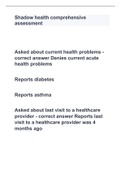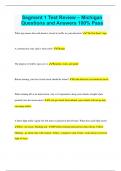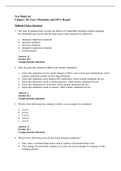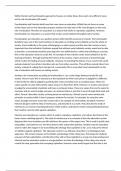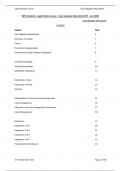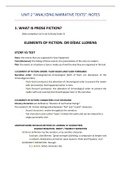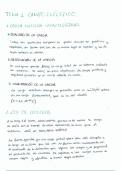Computing Notes OCR
Boolean Logic
Computers open/close circuits to send electrical signals. Computers use binary to store data as it is
easy to understand since there are only two values – easy to use in the system
on = 1 = HIGH
off = 0 = LOW
Logic Gate = A device that implements a Boolean function. An operation on one or more inputs that
produces one output.
Transistors = A microscopic device that uses close circuits to communicate electrical signals.
AND = Only has an output of 1 if both A AND B are 1. Written as A⋀B
OR = Has an output of 1 if either of A OR B are 1. We write this as A ⋁ B
NOT = Only one input. Inverts or swaps the input. Written as NOT A.
Truth tables = Shows what an output will be, based on the inputs.
Logic circuits = An electronic circuit used in computers to perform a logical operation with two/more
inputs
When drawing a diagram, brackets must be first. The order of precedence other than that is NOT,
AND, OR.
Memory
Bit Represent 1/0 1
Nibble Useful when converting between 4
binary/hexadecimal. Covers decimals 0-15
Byte Building block for every measurement. 8
Keyboard characters take up 1 byte
Kilobyte Document file size 1000 bits
Megabyte Measures transmission speeds on the web 1000KB
and storage on CDs
Gigabyte Could hold 3000 books or ¼ a film 1000MB
Terabyte Common for hard disks now. 300 hours of 1000GB
video or 1000 copies of the encyclopaedia
Petabyte 2000 years’ worth of songs or 315 million 3MB 1000TB
photos
Note that it is also in units of 1024
Calculating Eg. =
Text file, 1 byte per character and overhead of 10%
So a text file with 1000 characters will have roughly
1000 x 1.1 = 1100
1100/1000 = 1.1 KB – since KB is document file size
,Binary Number system:
Hexadecimal use the base-16 number system. This means there are 16 possibilities:
0, 1, 2, 3, 4, 5, 6, 7, 8, 9, A, B, C, D, E,F
10, 11, 12, 13, 14, 15
To do the reverse, divide the number by 16 and record the remainder.
Eg. 167/16 = 10 (A)
Remainder is 7 so the answer is A7
To convert 10101011 into Hex, we can use the following steps:
Table is 8, 4, 2, 1
1. Split into two nibbles: 1010 1011
2. Convert each nibble into decimal: 1010 = 10(A) 1011 =11(B)
3. Therefore 10101011 in Hex is AB
Hexadecimals are used by computer scientists for the following reasons:
• binary produces long strings and can be difficult to work with. Hex is shorter.
• hex can be easily converted to/from binary as there is 1 hex digit per nibble.
• hex is less susceptible to error.
ASCII = American Standard for Information Interchange. It uses 1 byte to store all of the characters
needed for the English language. This gives 256 possible characters, enough for English.
Unicode was developed to account for every language in the world. It uses 2 bytes – 65, 536 possible
values.
Storage of Images
BITMAP – page is split into an invisible grid and each pixel is assigned a colour. Quality depends on
the number of pixels.
Vector - Drawn by following a set of mathematical instructions: Draw a circle, radius: 6 pixels, centre:
10, 10, line thickness: 1 pixel
Metadata – data about data, like file size/type, how many pixels there are/depth of file.
Resolution – number of pixels used. On average, computer screens are 1,366 x 768.
High colour depth = more realistic colours, larger file. 1 bit allows 2 colours, 8 bit allows 256.
Direct colour = mixing appropriate amounts of a colour channel. R G B and an alpha channel which
handles transparency.
, Storage of Sound
Sound exists as waves, but computers will not be able to understand this, so it is stored as samples
and saved as audio files.
Sample frequency/rate The number of audio samples captured every second.
Sample size/bit depth Number of bits available to store each sample, e.g 16-bit.
The higher the bit depth, the higher the quality of the
audio. 16 bit (65536 values) on a CD and 24 bit (over
16000000 values) on a DVD.
Sample rate Measured in Hertz (Hz). The more samples, the more
detail as to the location of the waves, the higher the
quality.
Bit rate is calculated by doing frequency x channels x bit depth
A typical uncompressed audio file would have 2 channels, 44100 samples and a bit depth of 16. So
the calculation would be 16 x 2 x 44100 = 1411200 b/s (bits per second)
4 minutes of this would be 1411200 x 240 = 338688000 bits = 40.37 MB
Algorithms
Computational thinking = The use of computers to solve problems, development of algorithms, using
abstraction, decomposition, and algorithmic thinking.
Abstraction = removing the unnecessary parts of a problem
Decomposition = Breaking down larger problems to solve the smaller ones independently, then
combined.
Algorithmic Thinking = Identifying the steps used to solve a problem.
An algorithm is a process or set of rules to be followed in calculations or other problem-solving
operations, especially by a computer.
Basic Pseudocode
Variables
Variables are assigned using the = operator.
x=3 name=”Bob”
Casting
Variables can be typecast using the int str and float functions
str(3) returns “3”
int(“3”) returns 3
float(“3.14”) returns 3.14
Outputting to screen
print(“hello”)
name = input(“input name”)
Iteration – Count Controlled
for i=0 to 7
print(“Hello”)
next i
This will print hello 8 times
Iteration – Condition Controlled
while answer!=”computer”



